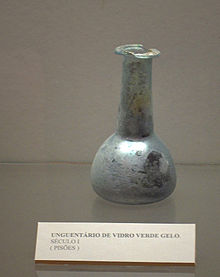
A lacrymatory, lachrymatory or lacrimarium (from the Latin lacrima, 'tear') is a small vessel of terracotta or, more frequently, of glass, found in Roman and late Greek tombs, and formerly supposed to have been bottles into which mourners dropped their tears. They contained perfumes and unguents, and the finding of so many of these vessels in tombs is due to the use of unguents at funeral ceremonies. They are shaped like a spindle, or a flask with a long small neck and a body in the form of a bulb.
The term lacrimarium is deceptive; there is no evidence from the ancient world to suggest the use of these glass or ceramic vessels as 'tear-catchers'.
References
- Vatomsky, Sonya (2 May 2017). "Debunking the Myth of 19th-Century 'Tear Catchers'". Atlas Obscura. Retrieved 23 August 2021.
-
 One or more of the preceding sentences incorporates text from a publication now in the public domain: Chisholm, Hugh, ed. (1911). "Lacrymatory". Encyclopædia Britannica. Vol. 16 (11th ed.). Cambridge University Press. p. 55.
One or more of the preceding sentences incorporates text from a publication now in the public domain: Chisholm, Hugh, ed. (1911). "Lacrymatory". Encyclopædia Britannica. Vol. 16 (11th ed.). Cambridge University Press. p. 55.
- Anderson-Stojanovic, V.R. 1987. "The Chronology and Function of Ceramic Unguentaria", American Journal of Archaeology Vol. 91. 105–122.
External links
- lacrymatory at the Free Dictionary
This ancient Rome–related article is a stub. You can help Misplaced Pages by expanding it. |